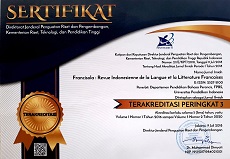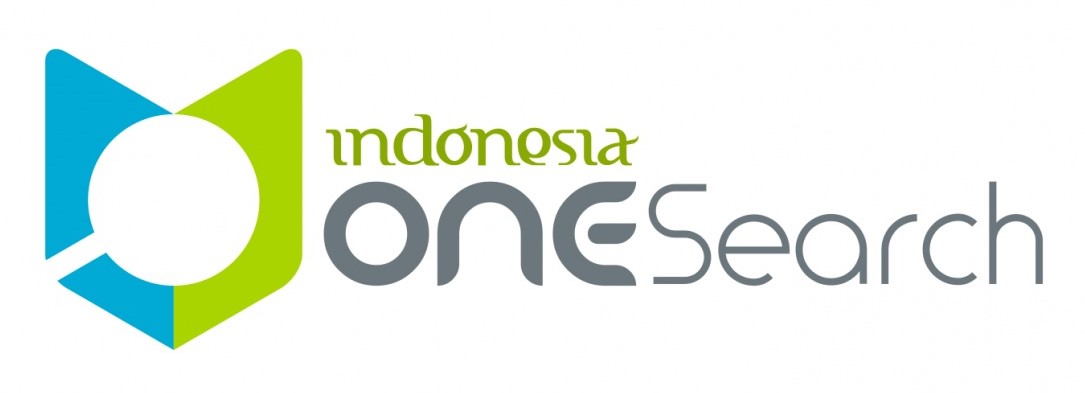Effets de la mise en œuvre de la classe inversée à travers Edmodo dans l’apprentissage de la grammaire
Abstract
RÉSUMÉ. La stratégie de classe inversée, comme l’une des stratégies de l’apprentissage hybride, a eu un impact positif sur le changement des méthodes d’enseignement traditionnelles, qui passent généralement du temps en classe, en les combinant de manière virtuelle. Cette étude tente d’étudier les effets de la stratégie de classe inversée en utilisant Edmodo dans l’apprentissage de la grammaire française. L'étude est menée en utilisant la méthode quantitative avec le modèle quasi expérimental. Les participants à cette recherche sont les étudiants qui ont étudié la grammaire française du niveau A1 / A2 du CECRL dans une université en Indonésie. Les résultats montrent que cette stratégie contribue positivement à l’amélioration des performances des étudiants en matière de grammaire. Cette étude devrait contribuer à offrir un autre aperçu de la conception et des résultats de l’application du matériel d’apprentissage par le biais de la stratégie de la classe inversée, notamment à travers la plateforme Edmodo.
Mots-clés : apprentissage hybride, classe inversée, Edmodo, grammaire.
ABSTRACT. The strategy of flipped classroom, like one of the blended learning’s strategies, had a positive impact in the change of the traditional methods of teaching, which normally spend time in the classroom, by combining them with those in a virtual way. This study attemps to investigate the effects of flipped classroom strategy using Edmodo in the French grammar learning. The study is conducted by using the quantitative method with the model quasi-experimental. The participants of this research is the students who studied French grammar on CEFR level A1/A2 in one university in Indonesia. The results show that this strategy contributes positively to the improvement of the students’ performances in grammar subject. This study should contribute in offering another insight into the design and results of the application of learning materials through the flipped classroom’s strategy, in particular through Edmodo platform.
Keywords: blended learning, flipped classroom, Edmodo, grammar.
Full Text:
PDFReferences
Adewuyi, J. A., Bernard, A. O., & Adewuyi, R. A. (2015). Problems Of Learning Foreign Languages In Colleges Of Education And Universities In Nigeria: A Comparative Study Of English And French Languages. International Journal Of English Language Teaching (Vol. 3). Retrieved From www.eajournals.org
Al-Harbi, S. S., & Alshumaimeri, Y. A. (2016). The Flipped Classroom Impact in Grammar Class on EFL Saudi Secondary School Students’ Performances and Attitudes. English Language Teaching. https://doi.org/10.5539/elt.v9n10p60
Al-Mekhlafi, A. M., & Nagaratnam, R. P. (2011). Difficulties In Teaching And Learning Grammar In An Efl Context 1. International Journal (Vol. 4). Retrieved from www.e-iji.net.
Alhaysony, M., & Alhaisoni, E. (2017). EFL Teachers’ and Learners’ Perceptions of Grammatical Difficulties. Advances in Language and Literary Studies, 8(1), 188–199. Retrieved from http://www.journals.aiac.org.au/index.php/alls/article/view/3148/2607
Beaver, J. K., Hallar, B., Westmaas, L., & Englander, K. (2015). BLENDED LEARNING Lessons from Best Practice Sites and the Philadelphia Context PERC Research Brief. Retrieved from www.phillyeducationresearch.org.
Bergmann, J., & Sams, A. (2012). Flip Your Classroom: Reach Every Student in Every Class Every Day. Retrieved from www.iste.org/learn/publications/permissions-and-
Butt, A. (2014). Student Views On The Use Of A Flipped Classroom Approach: Evidence From Australia. Business Education & Accreditation, 6(1), 33–43. Retrieved from ftp://ftp.repec.org/opt/ReDIF/RePEc/ibf/beaccr/bea-v6n1-2014/BEA-V6N1-2014-4.pdf
Capone, R., De Caterina, P., & Mazza, G. (2017). Blended Learning, Flipped Classroom and Virtual Environment: Challenges and Opportunities for the 21St Century Students. In EDULEARN17 Conference (pp. 10478–10482). https://doi.org/10.21125/edulearn.2017.0985
Chachu, S. (2016). “I am speaking French but I am thinking in English”: An analysis of errors by students of the French language at the University of Ghana. Ghana Journal of Linguistics, 5(1), 37–54.
Correa, M. (2015). Flipping the Foreign Language Classroom and Critical Pedagogies: A (New) Old Trend. Higher Education for the Future, 2(2), 114–125. https://doi.org/10.1177/2347631115584122
Creswell, J.W. (2013). Qualitative Inquiry and Research Design: Choosing Among Five Approaches. Third edition. Washington DC: Sage.
Ekmekci, E. (2017). The Flipped Writing Classroom In Turkish Efl Context: A Comparative Study On A New Model. Turkish Online Journal of Distance Education. Retrieved from http://tojde.anadolu.edu.tr/yonetim/icerik/makaleler/1392-published.pdf
Graham, C. R. (2016). Blended learning systems : Definition , current trends , and future directions. In C. R. Bonk, C. J. & Graham (Ed.), Handbook of blended learning: Global Perspectives, local designs. (pp. 3–21). San Francisco, CA: Pfeiffer Publishing.
Kaménova, S. (2017). Concevoir Un Cours Hybride En Français Des Affaires. Francisola, 1(2), 196. https://doi.org/10.17509/francisola.v1i2.5557
Kara, S. (2016). How And Why? Edmodo As A Blended Learning Tool: A Brief Overview Of Usage And Research. https://doi.org/10.5171/2013.657749
Köroğlu, Z. Ç., & Çakır, A. (2017). European Journal of English Language Teaching Use Of Flipped Instruction In Language Classrooms; An Investigation About Student Teachers’ Perceptions. European Journal of English Language Teaching, 3, 18. https://doi.org/10.5281/zenodo.852508
Liu, M. (2013). Blended Learning in a University EFL Writing Course: Description and Evaluation. Journal of Language Teaching and Research, 4(2), 301–309. https://doi.org/10.4304/jltr.4.2.301-309
Purnawarman, P., Susilawati, S., & Sundayana, W. (2016). The use of Edmodo in teaching writing in a blended learning setting. Indonesian Journal of Applied Linguistics, 5(2), 242. https://doi.org/10.17509/ijal.v5i2.1348
Redhouane, K., & Gamal, P. F. B. (2017). L’Enseignement Explicite et/ ou Implicite de la Grammaire en 4ème A.M : Quelle Démarche faut-il Choisir en Classe de FLE. Revue Académique Des Études Humaines et Sociales, 18, 34–46. Retrieved from http://www.univ-chlef.dz/ratsh/la_revue_N_18/Article_Revue_Academique_N_18_2017/Lettre_philosophie/Article_16.pdf
Shabiralyani, G., Hasan, K. S., Hamad, N., & Iqbal, N. (2015). Impact of Visual Aids in Enhancing the Learning Process Case Research: District Dera Ghazi Khan. Journal of Education and Practice, 6(19), 226–233. Retrieved from www.iiste.org
Warden, A. (2016). Investigating the use of a Flipped Approach to Grammar Input in an English as a Foreign Language Classroom. The University of Chichester. Retrieved from https://englishagenda.britishcouncil.org/sites/default/files/attachments/mda2017_university_of_chichester_nile_alexandra_warden.pdf
DOI: https://doi.org/10.17509/francisola.v3i2.15750
Refbacks
- There are currently no refbacks.
Copyright (c) 2019 FRANCISOLA

This work is licensed under a Creative Commons Attribution-ShareAlike 4.0 International License.
View My Stats











